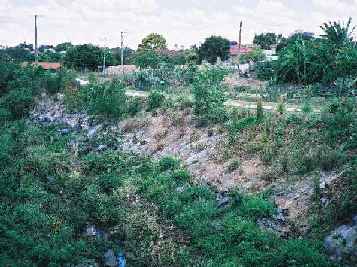Introduction
Site history
Site issues/difficulties
Weeds observed on site
Contact details
Introduction
The Colac Street Revegetation Group formed out of an interest to restore a section of a tributary of Kedron Brook near Colac Street, Kedron. The area was a weed-infested eyesore that the group hoped to transform into a condition suitable for use by wildlife and local residents.
Their work aimed to improve aesthetic, wildlife, and water quality values, as well as providing a starting point for a natural area corridor along the creek.
In late 1999, Brisbane City Council was approached for advice and assistance with regards to restoring the creek. Jenny Leask (Habitat Brisbane Officer – North) was impressed with their enthusiasm and she made arrangements so that they could do a trial planting.
They were successful in their application for funding and assistance from the Habitat Brisbane Program and for some years,, they continued to carry out restoration work along the creek.
Now, this group no longer exists as a part of the Habitat Brisbane groups though locals may be helping to maintain the area.
Site history
Originally, the site was mostly weed infested with very few native plants and was of little value for wildlife.
Once they started their restoration efforts, the aesthetics of the site were improved greatly with the planting of a variety of eucalypt woodland trees, shrubs, grasses and vines.
The group noticed birds, lizards and invertebrates utilising the habitat provided by their plantings. They hoped that this positive trend of increased usage by wildlife would continue as their plantings matured and provided habitat for a greater range of wildlife.

Site issues/difficulties
Steep slope
The site is a section of the creek with steep banks, which present difficulties for restoration work. For safety reasons, only adults undertook planting on the steep sections. Buckets were used to carry mulch to plants on the slope.
Heavy weed infestation
The site is heavily weed infested with about 30 different species of weed. This presents difficulties because the site is not capable of undergoing natural regeneration, as there is no remnant native vegetation on site or nearby from which regeneration can occur.
To overcome this problem a variety of weed control methods were used at Colac Street and native plants were used to help suppress and replace the introduced species.
Weeds observed on site
| Common name | Botanical name |
|---|---|
| Annual Ragweed | Ambrosia artemisiifolia |
| Blackberry Nightshade | Solanum americanum |
| Blue Morning Glory | Ipomoea indica |
| Castor Oil Plant | Ricinis communis |
| Chinese Elm | Celtis sinensis |
| Cobbler’s Pegs | Bidens pilosa |
| Curled Dock | Rumex crispus |
| Devil’s Fig | Solanium |
| Glycine | Glycine sp. |
| Green Cestrum | Cestrum parqui |
| Guinea Grass | Panicum maximum |
| Japanese Sunflower | Tithonia diversifolia |
| Johnson Grass | Sorghum halepense |
| Kikuyu Grass | Pennisetum clandestinum |
| Madeira Vine | Anredera cordifolia |
| Mile - a - minute | Ipomoea cairica |
| Milk Thistle | Sonchus oleraceus |
| Nut Grass | Cyprus rotundus |
| Paddy’s Lucerne | Medicago sativa |
| Para Grass | Bracharia mutica |
| Plantain | Plantago sp. |
| Potato Weed | Solanium sp |
| Purple Top | Verbena bonariensis |
| Red Natal Grass | Rhynocephalum repens |
| Rhodes Grass | Chloris gayana |
| Siratro | Macroptilium atropurpureum |
| Swamp Dock | Rumex brownii |
| Thickhead | Crassocephalum crepidioides |
| Yellow Guava | Psidium guajava |
Contact Details
In past years, the contact was Mr. Gary Sands as Group Leader.
(C. Ivin 09/12/2010)
CI 14/10/2011

